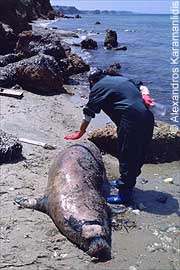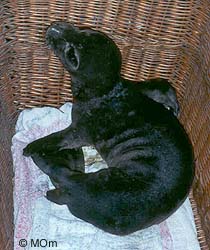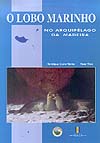 |
|
|
 |
||
Albania / Croatia / Cyprus / Greece / Madeira / Mauritania & Western Sahara / Turkey
 |
|
|
 |
||
Albania / Croatia / Cyprus / Greece / Madeira / Mauritania & Western Sahara / Turkey
Natura 2000 sites attract vital support
Leading Greek NGO, the Hellenic Society for the Study & Protection of the Monk Seal (MOm) continues to take major strides towards the establishment of key Natura 2000 reserve areas for M. monachus (see Research Continues for Natura 2000 Reserves, IFAW-ODYSSIA Surveys Aegean Target Areas, and Natura 2000 News).
Progress since May can be summarized as follows:
New law benefits protected areas
A new law issued in Athens in October creates a mechanism to establish management bodies in protected areas. After years of lobbying to have such legislation enacted, the event has been hailed by MOm and other conservation bodies as a groundbreaking step.
Historically, the operation of Greek protected areas – including the National Marine Park of Alonissos and the Northern Sporades (NMPANS) – have been severely compromised by a quirk in Greek legislation. In spite of the fact that existing legislation foresees three steps towards the establishment of protected areas – defining borders, devising protection measures and restrictions, and the design and establishment of management bodies – up to now there has been no law that allows for the implementation of the latter through Presidential decree.
This posed particular difficulties in already established protected areas, which – although they possess an active protection status – lack integrated management direction. The phenomenon resulted in an organizational vacuum, hampering long-term planning – such as alternative development opportunities, and regulatory enforcement.
The law approved by the Greek parliament, however, will now pave the way for the creation and establishment of management bodies for the protected areas.
In a potentially significant development, the law allows the possibility for the state to create management bodies that operate within the private sector as non-profit organisations.
Management bodies will be governed by a board of directors (comprising 7-11 members), to include representatives of the Ministry of Environment, Agriculture, other relevant (to the area) ministries, representatives of local and regional authorities, specialists, and – in what is being seen as a major advance – representatives of environmental NGOs (which possess previous experience, activities and infrastructure within the geographical area, and are represented nationally).
The Law also suggests that the funding required for the management body to function be available from various sources, including the central government, the EU, and the private sector.
News of the law will be particularly welcome to the NMPANS, whose supporters have been campaigning for a presidential decree establishing a management body since 1992. – Vrassidas Zavras, MOm.
LIFE funding rejected for new millennium
Despite the notable achievements related above, The Monachus Guardian has learnt that DGXI of the European Commission, the Directorate that administers the LIFE-Nature fund, has rejected MOm’s application for a continuance of the integrated activity project in Greece. Furthermore, sources in Brussels explain that potential LIFE III beneficiaries have fallen foul of bureaucratic delays in renewing and administering the fund, raising the prospect of funding shortages for up to one and a half years (see Winners & Loosers, International News).
The decision therefore threatens to cause significant disruption to various key objectives in the Aegean, most notably the implementation of management plans for EU-promoted Natura 2000 monk seal reserves.
MOm, while conceding that it is facing a considerable funding shortfall, has declined to comment on its LIFE funding proposals at this stage. However, The Monachus Guardian has reason to believe that the funding decision could jeopardise the entire monk seal conservation effort in the Aegean. – The Monachus Guardian.
European Network for Monachus monachus
Under a EU-funded (DG XI) initiative, an exchange programme has recently been launched involving several Mediterranean monk seal NGOs and research teams. The initiative comes in response to criticism in recent years that a lack of communication between NGOs has encouraged a fragmentary approach to conservation and research, resulting in conflict and duplication of effort. Although still in its infancy, it is hoped that the exchange programme will ultimately open up permanent lines of communication between the projects as well as opportunities for practical collaboration on a range of issues.
Coordinated by MOm and funded by the LIFE programme, exchange visits have so far taken place between Madeira and Greece, Greece and Spain (the University of Barcelona team working in Mauritania), Madeira and Spain. Although MOm plans to issue an assessment of the initiative by year’s end, appreciation expressed by participants is already prompting calls for other, non-EU, teams to join the scheme, such as Turkey and Mauritania. – Spyros Kotomatas, MOm.
Awareness campaign reaches out over Greece
Every summer for the last 9 years (1990-1999), MOm has conducted monk seal public awareness programmes throughout Greece.
This year alone, the organisation operated seven Information Centers: Alonissos (Patitiri and Steni Vala), Skopelos and Skiathos in the Northern Sporades, Milos in the Cyclades, Karpathos in the Eastern Aegean and Fourni in the Dodecanese.
All this was made possible through the dedicated efforts of 80 young supporters (between 19 and 41 years of age) who voluntarily offered their time and informed 22,000 island visitors about the plight of the monk seal and the need to preserve the marine environment. – Kelly Vouvoussiras, MOm.
Strandings report yields important findings
MOm’s long-term data gathering project on the strandings of dead monk seals is beginning to yield important findings on the mortality causes of the species.
The project was initiated in Greece in 1990 as part of a larger project, the Rescue and Information Network. The need for this study became imperative during the mass mortality of Striped Dolphins the Mediterranean, in order to evaluate the risk of similar epizootics in monk seals.
All information concerning dead seal strandings reaches MOm through the Rescue and Information Network. This network covers all of coastal and island Greece and its operation is based on continuous communication with more than 1000 "members" (port police authorities, fishery and veterinary services, fishing co-operatives, coastal municipalities and local inhabitants) through mail and direct visits.
Upon receipt of a report of a seal found dead, depending on the condition of the body, either a full necropsy is performed (in the case of a recently deceased animal), or an external examination (with body measurements) is conducted (in the case of a decomposed animal). The external and internal examination is performed following specific protocols on pinniped necropsies (Winchell 1990, Dierauf 1994). According to the state of decomposition of the carcass, tissue samples are taken for further examination: bacteriological, virological, immunological, histological, genetical, parasitological, toxicological, morphometrics, age determination, etc. The samples are stored in the sample bank of MOm and forwarded to collaborating institutes for analysis. The above activities are conducted under a specific permit from the Ministry of Agriculture.
Over the last ten years 130 dead seal strandings have been reported to MOm and 45 necropsies have been performed. The results of this work provide evidence that deliberate killing remains a major direct threat for the Mediterranean monk seal population, while natural deaths are the main cause of pup mortality. The results of the years 1990-1997 were presented in the paper Causes of mortality in the Mediterranean Monk seal (Monachus monachus) in Greece by E. Androukaki, S. Adamantopoulou, P. Dendrinos, E. Tounta & S. Kotomatas, published in the journal Contributions to the Zoogeography and Ecology of the East Mediterranean Region, Vol. I (1999): 405-411.
Furthermore, from the samples collected during this project, the occurrence of morbillivirus in the monk seal in Greek waters was found for the first time (see A.D.M.E. Osterhaus, M. van der Bildt, E. Vedder, B. Martina, H. Niesters, J. Vos, H. van Egmond, D. Liem, R., Baumann, E. Androukaki, S. Kotomatas, A. Komnenou, Abou Sidi Ba, A.B. Jiddou, & M.E.O. Barham. Monk seal mortality: virus or toxin? Vaccine 16 (1998) No 9/10: 979-981).
Additional research allowed for the classification of the identified virus as phylogenetically related to the porpoise morbillivirus (see M.W.G. van der Bildt, E. Vedder, B. Martina, Abou Sidi Ba, A.B. Jiddou, M.E.O. Barham, E. Androukaki, A. Komnenou, H.G.M. Niesters, A.D.M.E. Osterhaus. Morbilliviruses in Mediterranean Monk Seals, Vet. Microb. 69 (1999): 19-21).
During 1999, MOm, in its effort to further advance knowledge of the species’ biology, initiated a research project on the genetics of the Greek monk seal population in collaboration with the University of Barcelona. The genetic variability of the specific population will be investigated and a genetic comparison between the Greek and the Western Atlantic populations will be attempted. In addition, during the course of this year MOm, together with researchers from the faculty of Ocean Sciences, University of Bangor, N. Wales, has been conducting a study on the levels of heavy and trace metals in the tissues of monk seals, using samples collected over the years of the project from the dead animals. Both projects are anticipated to shed light on areas poorly investigated in the past.
In continuation of these efforts, during 1999 MOm’s team conducted necropsies on the following dead animals found along the Greek coast:

Adult female seal discovered at Potidaea beach, Chalkidiki.
MOm, considering this a priority project, has invested considerable effort in its continuous operation. Results gathered to date appear to validate its scientific and conservation value, particularly in offering an early warning system of potential direct risks to the monk seal population – Eugenia Androukaki, MOm.
Editor’s Note: Observers may find it especially ironic that, for the last 4 years, no one has provided financial assistance to this nation-wide project, obliging MOm to secure funds solely through donations from its members and supporters. This in spite of often-voiced concerns over the potentially catastrophic effects of a viral outbreak in the eastern Mediterranean...
MOm’s bibliography
MOm has released a bibliography of its publications issued between 1991–1999. The full bibliography is available in Acrobat (PDF) format in The Monachus Library, while MOm publications issued since April/May 1999 can also be found in this issue’s Recent Publications.
Gerakas revisited
Reconstruction work at the much-maligned Biological Station at Gerakas (Monachus Guardian 1:1) in the Northern Sporades Marine Park is now nearing completion. Although MOm has sometimes expressed frustration regarding the convoluted bureaucratic tangle (involving multiple national, regional and local administrative bodies) that has sometimes threatened to ensnare the project, The Monachus Guardian can confirm that the Station’s new monk seal rehabilitation facilities are almost complete.
Stop Press… Stop Press… Stop Press…

Orphaned monk seal pup Akritas
Shortly before this issue of The Monachus Guardian was due to go to press, MOm announced that an orphaned monk seal pup had been reported to its Rescue and Rehabilitation Network from the Aegean island of Ikaria. The male pup, named Akritas, approximately two weeks old, was subsequently taken to the MOm rehabilitation unit at Steni Vala on the Northern Sporades island of Alonissos. Please refer to our Breaking News section for further details.
Feeding behaviour study published
A study on the feeding behaviour of monk seals around the Desertas Islands was published earlier this year in Funchal, Madeira:
Costa Neves, H. 1999. Preliminary findings on the feeding behaviour and general ecology strategy of the Mediterranean monk seal Monachus monachus (Pinnipedia: Monachinae) on the Desertas Islands. Bol. Mus. Mun. Funchal Sup. no. 5: 263-271.
Thanks to the author, this paper is now available for download in the Monachus Library.
New book due by year’s end
The 120-page, fully illustrated, volume focuses on the history of the monk seal in Madeira and the Desertas Islands, and on non-invasive conservation efforts that have brought the species from the brink of extinction in 1988 – when only 6-8 individuals survived – to 20 individuals today.

The publication of The Monk Seal (Monachus monachus) in Madeira Archipelago, a book authored by Henrique Costa Neves and Rosa Pires (see The Monachus Guardian 2:1) has been delayed but is expected to appear by the end of the year. Although only a Portuguese edition will initially be available (O Lobo Marinho no Arquipélago da Madeira), an English version is planned in the future.
Mediterranean News continues with Mauritania & Western Sahara and Turkey...
Copyright © 1999 The Monachus Guardian. All Rights Reserved